

|
| SCHWEIZ / SUISSE / SVIZZERA / SVIZRA | SWITZERLAND |
| Zürich / Zurich / Zurigo / Turitg |
rm: Turitg
| fr: Zurich
| de: Zürich
| it: Zurigo
| |
mk, color=228855>Цирих |
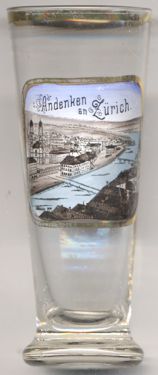 Zürich is the largest city of Switzerland (362,500 inhabitants) and
capital of the canton of the same name. The town developed on the northern
end of the Zürichsee (Lake Zurich) on the banks of the rievr Limmat.
The year 15 BC is taken as the 'birth' of Zurich when the Romans founded
a border station called Turicumon this place. In the Early and High
Middle Ages Zürich was one of the Imperial residences. In 1351, the town
joined the Swiss Confederation. The Reformation was introduced in 1519 by
Huldrych Zwingli. During the 19th century Zürich became one of the most
important financial and economical centres. Zürich has the world's fourth
largest stock exchange and is the most important trading place for gold.
Zürich is the largest city of Switzerland (362,500 inhabitants) and
capital of the canton of the same name. The town developed on the northern
end of the Zürichsee (Lake Zurich) on the banks of the rievr Limmat.
The year 15 BC is taken as the 'birth' of Zurich when the Romans founded
a border station called Turicumon this place. In the Early and High
Middle Ages Zürich was one of the Imperial residences. In 1351, the town
joined the Swiss Confederation. The Reformation was introduced in 1519 by
Huldrych Zwingli. During the 19th century Zürich became one of the most
important financial and economical centres. Zürich has the world's fourth
largest stock exchange and is the most important trading place for gold.
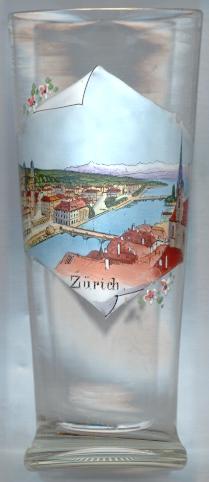 The
The  Grossmünster [left, no. 638: far left]
is Zürich's most famous landmark. The church is believed to be of Carolingian origin.
The construction began in 1039 and was not fully completed until the 14th
century. Remains of the Romanesque cloister with important sculptures date
back to the late 12th century. The earlier canonic educational institution
of the Grossmünsterstift was replaced by the first school for girls in 1853.
Today it houses the theological faculty of the University.
Grossmünster [left, no. 638: far left]
is Zürich's most famous landmark. The church is believed to be of Carolingian origin.
The construction began in 1039 and was not fully completed until the 14th
century. Remains of the Romanesque cloister with important sculptures date
back to the late 12th century. The earlier canonic educational institution
of the Grossmünsterstift was replaced by the first school for girls in 1853.
Today it houses the theological faculty of the University.
Right next to the river Limmat at the bridge Münsterbrücke, the open hall of
the  Helmhaus [left, no. 638: centre left]
originally served as a court and a canvas market. The name is derived from the
old word 'helmen' which means 'to protect'. The building that we see today
replaced an older building in 1794. Today, the Helmhaus houses
a gallery for young artists.
Helmhaus [left, no. 638: centre left]
originally served as a court and a canvas market. The name is derived from the
old word 'helmen' which means 'to protect'. The building that we see today
replaced an older building in 1794. Today, the Helmhaus houses
a gallery for young artists.
Behind the Helmhaus on the bank of the Limmat, the
 Wasserkirche [left, no. 638: centre]
is believed to stand on the place of the burial place of St. Felix and
St. Regula, the patron saints of Zürich. The Gothic church which we can
see today was built between 1479 and 1484. Like most churches in Switzerland
it was robbed of its original treasures during the Reformation.
Wasserkirche [left, no. 638: centre]
is believed to stand on the place of the burial place of St. Felix and
St. Regula, the patron saints of Zürich. The Gothic church which we can
see today was built between 1479 and 1484. Like most churches in Switzerland
it was robbed of its original treasures during the Reformation.
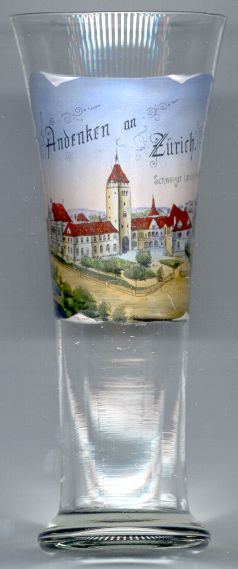 The
The  Fraumünster [left, no. 638: far right]
was the church of the noblewomen of Zürich. It was a gift of King Ludwig the
German, grandson of Charlemagne. In AD 853 Hildegard, the daughter of Ludwig,
became the first abbess. Only parts of the foundations of the building and
the crypt of the old abbey remain from the original church. Today's church
was begun in the 12th century. Paintings in the Gothic cloister show scenes
from the legends of old Zürich. A series of stained glass windows designed by
Marc Chagall was installed in the Romanesque choir in 1970.
Fraumünster [left, no. 638: far right]
was the church of the noblewomen of Zürich. It was a gift of King Ludwig the
German, grandson of Charlemagne. In AD 853 Hildegard, the daughter of Ludwig,
became the first abbess. Only parts of the foundations of the building and
the crypt of the old abbey remain from the original church. Today's church
was begun in the 12th century. Paintings in the Gothic cloister show scenes
from the legends of old Zürich. A series of stained glass windows designed by
Marc Chagall was installed in the Romanesque choir in 1970.
The  Swiss National Museum (Schweizerisches Landesmuseum) [right, no. 1110]
was built in 1898 in historicist style. The tower, designed after the town gate of Baden (canton Aargau), has become a landmark of Zurich.
The museum houses the largest cultural-historical collection of Switzerland.
Swiss National Museum (Schweizerisches Landesmuseum) [right, no. 1110]
was built in 1898 in historicist style. The tower, designed after the town gate of Baden (canton Aargau), has become a landmark of Zurich.
The museum houses the largest cultural-historical collection of Switzerland.
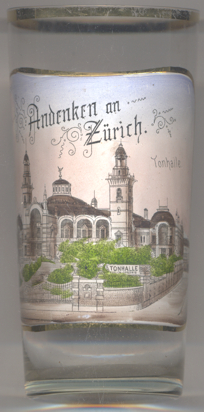
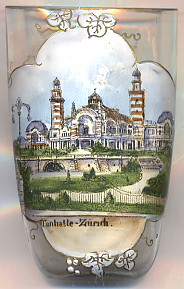
The  Neue Tonhalle [left, no. 3490, and right, no. 2937]
was built in 1893–1895 in Hitoricist style by the architects Ferdinand Fellner jr. and Hermann Helmer from Vienna.
Parts of the building were torn down in 1937 and were replaced by the new Kongresshaus in 1939. The concert halls, already part of the original Neue Tonhalle,
still are among the best in Europe.
Neue Tonhalle [left, no. 3490, and right, no. 2937]
was built in 1893–1895 in Hitoricist style by the architects Ferdinand Fellner jr. and Hermann Helmer from Vienna.
Parts of the building were torn down in 1937 and were replaced by the new Kongresshaus in 1939. The concert halls, already part of the original Neue Tonhalle,
still are among the best in Europe.
[https://de.wikipedia.org/wiki/Tonhalle-Orchester_Zürich]
See also list of other buildings by Fellner & Helmer depicted on glasses in this collection.
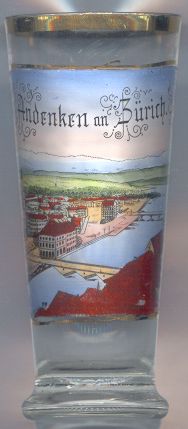
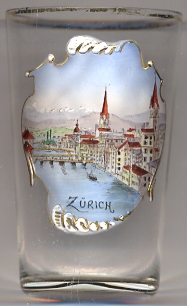
![[scale]](lineal.jpg)